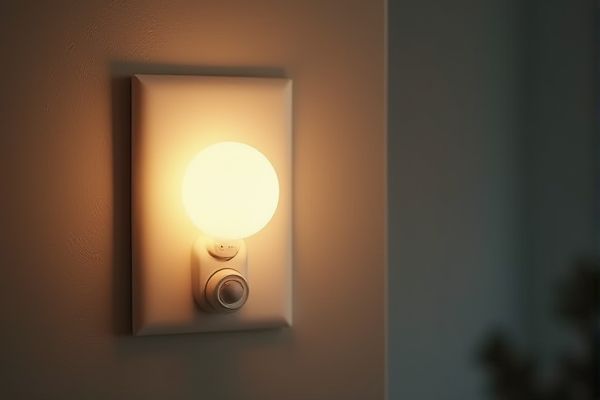
Motion sensor lights automatically detect movement and illuminate spaces without requiring physical effort, enhancing security and energy efficiency, while manual switch lights give you direct control but may lead to lights being left on unnecessarily. Discover the key differences and decide which lighting solution best suits your needs by reading the rest of the article.
Table of Comparison
| Feature | Motion Sensor Light | Manual Switch Light |
|---|---|---|
| Operation | Automatically turns on/off based on motion detection | Requires manual on/off switching |
| Energy Efficiency | High - reduces wasted energy by activating only when needed | Lower - may be left on unintentionally, wasting energy |
| Convenience | Hands-free, ideal for entryways, garages, and security lighting | Requires physical interaction to operate |
| Installation Complexity | Moderate - requires sensor wiring or integration | Simple - standard switch installation |
| Cost | Higher initial investment due to sensor technology | Lower initial cost |
| Security | Enhances security by illuminating areas upon detecting movement | Depends on user action; less proactive |
| Customization | Adjustable sensitivity and timer settings | Limited to manual control only |
Introduction to Motion Sensor and Manual Switch Lights
Motion sensor lights automatically detect movement to activate lighting, enhancing energy efficiency and security in homes and commercial spaces. Manual switch lights require user intervention to turn the light on or off, offering straightforward control and reliability. Both options serve distinct purposes depending on convenience, energy savings, and application needs.
How Motion Sensor Lights Work
Motion sensor lights operate using infrared or ultrasonic sensors that detect movement within a specific range, triggering the light to turn on automatically. These sensors capture changes in heat or sound waves, enabling energy-efficient lighting by activating only when motion is present. Unlike manual switch lights, motion sensor lights enhance security and convenience by providing hands-free illumination based on real-time activity.
Manual Switch Lights: Traditional Operation
Manual switch lights provide reliable, user-controlled illumination through a simple on/off switch, allowing precise control over when your space is lit. These lights do not rely on sensors, ensuring consistent performance regardless of motion or ambient conditions. Your personal input guarantees that lighting is only used when needed, potentially conserving energy by avoiding unnecessary activation.
Energy Efficiency Comparison
Motion sensor lights use infrared or microwave sensors to detect movement, automatically turning off when no activity is present, significantly reducing energy waste compared to manual switch lights that often rely on user memory to switch off. Energy efficiency is enhanced by motion sensor lights because they operate only when needed, cutting electricity usage by up to 40% in some residential and commercial settings. Your energy bills and carbon footprint both benefit from adopting motion sensor lighting, especially in areas with irregular occupancy.
Installation and Maintenance Differences
Motion sensor lights require more complex installation involving wiring to the sensor unit and configuring sensitivity settings, whereas manual switch lights have straightforward wiring directly to a switch. Maintenance for motion sensor lights includes periodic sensor cleaning and occasional recalibration to ensure accurate detection, while manual switch lights primarily need basic bulb replacement and switch checks. Your choice impacts ongoing upkeep, with motion sensor systems demanding more technical attention compared to the simplicity of manual switches.
Convenience and User Experience
Motion sensor lights enhance convenience by automatically illuminating spaces when movement is detected, eliminating the need for manual operation and ensuring hands-free access. Manual switch lights offer direct control, allowing you to adjust lighting precisely based on your immediate preferences, which can be more reliable in scenarios with frequent interruptions or variable occupancy. Balancing automation with user control optimizes your experience, as motion sensor lights provide effortless usability while manual switches offer personalized flexibility.
Security Benefits: Sensor vs Manual Lights
Motion sensor lights enhance security by automatically illuminating areas when movement is detected, deterring potential intruders and increasing visibility during nighttime. Manual switch lights rely on occupant awareness to activate, which can result in vulnerable moments of darkness if lights are not turned on promptly. Sensor lights provide consistent, hands-free operation that improves safety around property entrances, driveways, and pathways.
Cost Analysis: Upfront and Long-Term
Motion sensor lights typically have a higher upfront cost due to advanced sensor technology and installation requirements, averaging around $50 to $150 per unit, compared to manual switch lights which cost approximately $10 to $30 per fixture. Long-term savings with motion sensor lights stem from reduced energy consumption, as lights operate only when motion is detected, potentially lowering electricity bills by up to 30% annually. Manual switch lights incur consistently higher energy costs since they rely on human operation, often leading to lights being left on unnecessarily and increasing overall utility expenses.
Ideal Use Cases for Each Lighting Option
Motion sensor lights are ideal for areas where automatic illumination enhances safety and convenience, such as outdoor pathways, garages, and security zones, ensuring your space is well-lit only when needed. Manual switch lights offer precise control and consistent lighting, making them suitable for indoor rooms, workspaces, and areas requiring adjustable or prolonged light use. Choosing between these options depends on your specific lighting needs, usage patterns, and the importance of energy efficiency or automation in your environment.
Choosing the Right Light for Your Space
Motion sensor lights enhance energy efficiency and security by automatically illuminating when movement is detected, perfect for high-traffic or outdoor areas. Manual switch lights provide full control over lighting preferences, ideal for spaces where you want to customize brightness and timing. Your choice depends on usage patterns, with motion sensors suited for convenience and energy savings, while manual switches offer personalized lighting control.
 homyna.com
homyna.com